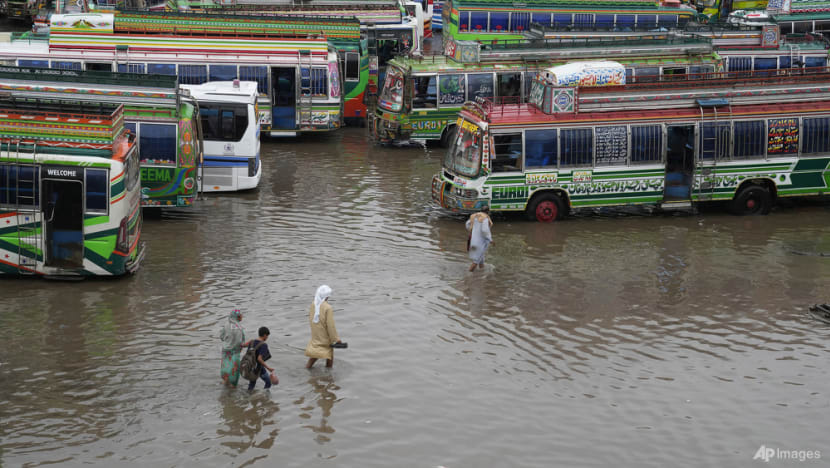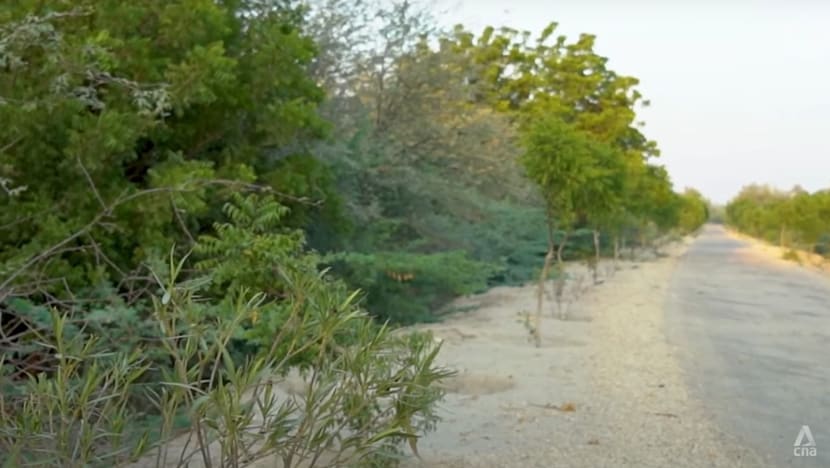Pakistan calls for US$6.8 trillion in climate funding for developing countries
Pakistan ranks as the world’s fifth-most vulnerable country to climate-induced disasters, despite contributing less than 1 per cent to global greenhouse gas emissions.

Passengers wade through a flooded bus terminal caused by heavy monsoon rainfall in Lahore, Pakistan, Jul 5, 2023. (File Photo: AP/K.M. Chaudary)

This audio is generated by an AI tool.
SINDH, Pakistan: Officers scan screens for signs of trouble at the headquarters of Pakistan’s National Disaster Management Authority, located in capital Islamabad.
Using nearly 300 climate sensors, they track rain patterns and signs of unusual weather disturbances in all four of the country’s provinces. When required, a warning is issued to evacuate people.
This system was used to alert officials about flood risk in Punjab province last year, enabling authorities to move over 150,000 people to safety.
Barely two years in operation, it was set up in response to the South Asian nation’s painful lessons from the devastating 2022 floods which submerged a third of the country, killing 1,700 and impacting about 33 million people.
Such climate catastrophes have become increasingly frequent, leaving vulnerable communities little time to recover.
CALLS FOR THE WEST TO HELP
Pakistan ranks as the world’s fifth-most vulnerable country to climate-induced disasters, despite contributing less than 1 per cent to global greenhouse gas emissions.
Islamabad has said the Global South should come together to demand funds from the West, and that mitigation efforts in vulnerable countries should be funded by the developed world.
The federal government last year unveiled an ambitious National Adaptation Plan to build climate resilience as well as address income inequality and social disparities.
This week, Pakistani Prime Minister Shehbaz Sharif joined world leaders at the annual United Nations-led climate summit COP29 in Azerbaijan’s capital Baku, where he called for US$6.8 trillion in climate funding for developing countries such as his by 2030.
Speaking at a climate finance roundtable hosted by Pakistan, he stressed that developing countries face huge climate challenges but are often left without adequate resources to meet them.
According to World Bank estimates, a comprehensive response to Pakistan’s climate and development challenges could cost about US$348 billion by 2030.
Ms Romina Khurshid Alam, coordinator to the prime minister on climate change, said: “It's a human rights issue as well.
“It’s a climate justice (that needs) to be done because the countries that are developing - they are struggling so much and they need to be heard.”
Related:
DEFORESTATION AMONG MAN-MADE FACTORS
Man-made factors have contributed to Pakistan’s climate-induced problems, according to experts.
In the southeastern province of Sindh, for instance, deforestation has been rampant for decades and eroded the surrounding region’s ability to withstand extreme rainfall.
Environmental researcher David Fugazza from the University of Milan pointed to evidence that with climate change, the intensity of monsoon rains has increased over the years.
“If there is no proper land management, these devastating rains can cause floods,” he stressed.
To increase its green cover on the ground, the Sindh provincial government has implemented strict measures.
Forest guards now regularly patrol the Pai Forest area, which has suffered illegal land grabs and large-scale logging to make way for agriculture.
Mr Ramiz Raja, assistant commissioner of the Sakrand Division in Sindh’s Nawabshah city, noted that the Pai Forest - which is a reserved forest - has now banned the cutting down of trees.
“We have established a nursery from where we get the plants and plant them,” he said, referring to reforestation efforts.

“NO ONE CAME TO OUR AID”
Pakistan’s extreme vulnerability to climate disaster is made more acute by high levels of poverty across the country.
Waterborne diseases have been on the rise after the 2022 floods, particularly affecting children, while the country is still struggling to rebuild homes. Crops were inundated by flood waters and irrigation systems were also destroyed.
Mother-of-six Naseem Khatoon is still trying to piece back her life after the floods left her family homeless and destitute.
“No one came to our aid - neither our landlord nor the government. They took votes from us, but nobody came to help us. We helped each other,” she told CNA.
Beyond immediate worries of shelter and food, however, is the overwhelming uncertainty over what lies ahead.
Ms Khatoon said her community lives in constant fear of the next time a disaster strikes.
“Whenever it rains and the floodwaters rise, our homes get flooded too, and that brings snakes and other insects into our homes. It is all very terrifying, especially since we have children at home,” she added.
















